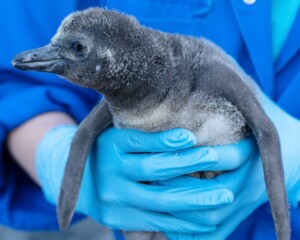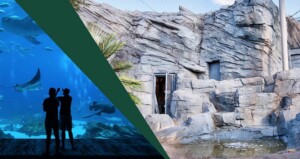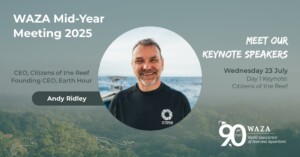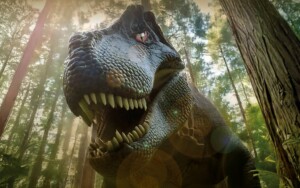The National Aquarium, Baltimore, one of the world's leading aquariums, which champions environmental initiatives and draws 1.4 million visitors a year, is undergoing a process of renewal and reinterpretation.
The CEO of the Aquarium, John Racanelli, leads its mission to inspire conservation of the world’s aquatic treasures.
Blooloop caught up with him to look at his love of the oceans, the new Blacktip Reef exhibit and the plans for a new presence for the National Aquarium in Washington, DC, replacing the one which closed its doors for the last time to the public in September 2013.
Diving, Aquariums and Google Ocean
John Racanelli, who has been fascinated by the ocean all his life, is a SCUBA diver, open-water swimmer, sailor and surfer.
“I never really contemplated any kind of profession that didn’t involve the ocean and conservation.”
At the age of eight, he wrote down his ambitions with his friends. His was to be a deep-sea diver and travel  the world teaching people about the ocean.
the world teaching people about the ocean.
He was certified as a SCUBA diver at the age of 15, and by 17 had found a job as a diver at a marine park on the San Francisco Bay.
At university he majored first in Biology then in Environmental Studies, ultimately earning a BS in Strategic Management from the School of Business at Dominican University of California.
He punctuated his years of study with marine occupations including sailing as navigator aboard a tall ship on a 6000 mile long voyage, and working as a diver at Marine World in San Francisco. In 1984 he was appointed as the Monterey Bay Aquarium’s first director of marketing, after which he spent 16 years in leadership positions at US aquaria.
He then formed Racanelli Partners, Inc., a San Francisco-based consulting firm which served the needs of non-profit leaders nationally and globally, focusing on cultural and conservation organizations including Mission Blue/Sylvia Earle Alliance, the International Union for the Conservation of Nature and the Surfrider Foundation. After co-founding Mission Blue with author and oceanographer Dr Sylvia Earle, he collaborated with her in developing and launching Google Ocean, Google’s most significant enhancement of Google Earth.
Why the Earth is not like Venus
Racanelli joined the National Aquarium, Baltimore in July 2011.
His commitment, expertise and lifelong passion for his work make him a compelling ambassador for marine ecology and advocate of education on the fundamental importance of maintaining the health of the ocean and its inhabitants.
Racanelli explains, “Earth is an ocean planet. The ocean is our life support system. Every four out of five breaths you take are coming to you courtesy of the phytoplankton in the ocean. It generates significantly more oxygen than all the rainforests and land masses combined.”
The ocean also moderates the weather moderation and has carbon absorption properties. “Without it, this planet would be like Venus, ” he adds.

Engaging Visitors and the New Blacktip Reef Exhibit
Racanelli is aware that if the Aquarium is to fulfil its function of driving conservation action worldwide, educating and inspiring the public and changing the way the world views the ocean and aquatic systems its methods of delivering its message must be relevant, evolving so visitors remain engaged.
“You do have to renew and refresh yourself in order for people to want to come back.”
Of the new $12.5 million Blacktip Reef exhibit he says: “Blacktip Reef is the first in what I hope will be a very exciting series of major new exhibits.”
Blacktip Reef is a ground-breaking experience that gives visitors the chance to immerse themselves in an endangered coral ecosystem complete with sharks – without getting wet. It has a conservation message – the importance of coral reefs to the world ocean – at its heart.

Racanelli says, “A coral reef like this would take hundreds of years to develop in nature, and it has likewise been a major undertaking to create an Indo-Pacific reef for these blacktip reef sharks to call home. The result tells the same story here in the Aquarium as it does in nature – that coral reefs are stunningly beautiful but incredibly fragile ecosystems that need our care.”
Blacktip reef sharks and 65 other marine species including five foot wide whiprays (above), zebra sharks, wobbegong sharks and a sea turtle weighing over 500 pounds, have been integrated into the 260, 000 gallon exhibit, and innovative methods have been implemented to increase the immersive nature of the experience. The exhibit can be seen from three sides. From the upper level, visitors can look down from viewing platforms. On the lower level, there are daily diver presentations and a 27-foot panoramic viewing window that curves four feet into the underwater reef itself, meaning visitors are actually able to be among the sharks protecting the coral reef.

The Evolving Aquarium and Subtler Changes
Another major innovative exhibit is planned for 2015, focusing on the shorelines and aquatic life along the Atlantic coast. It will follow the same multifaceted approach as the Blacktip Reef exhibit, engaging with visitors in an ambitious and interactive way relevant to 21st century visitors.
With subsequent sustainable and ground-breaking enhancements, combining practical infrastructure improvements and ambitious, evolving exhibits, the Aquarium will re-imagine the way it tells the story of the Chesapeake Bay and other aquatic treasures in an innovative way for a contemporary public.
Other, subtler changes at the Aquarium reflect an evolving attitude toward captive animals. The Aquarium’s redesigned Dolphin Discovery exhibit has replaced dolphin shows in favour of a more intimate and natural experience, where the dolphins can be observed eating, playing and interacting with trainers rather than performing. Unlike in the past when only a certain number of guests could attend planned shows, now all visitors have access to the exhibit for the entire day.

The closure of the National Aquarium in Washington
September 2013 saw the closure of the nation’s first public aquarium, located since 1932 in the U.S. Department of Commerce headquarters in Washington, DC, now called the Herbert C. Hoover Building, and previously operated in one form or another by the Fisheries Service since 1873.
Due to major renovations to the Commerce building, the Aquarium had to be dismantled, many of the animals being transferred to Baltimore, the rest travelling to other accredited institutions. However, Racanelli says, “We’re the National Aquarium. We’re committed to a National Aquarium presence in the nation’s capital.”
A strategic plan process, called BLUEprint, has been set in motion to identify feasibility and potential uses for a new facility in the capital. The National Aquarium team, headed by Racanelli, is working with expert planners and designers from Studio Gang Architects and IMPACTS Research & Development to establish exactly what form any future endeavours should take. Plans have not yet been made concrete, but Racanelli confidently foresees a great future for the Washington National Aquarium, and a possible partnership with the Smithsonian.

Forging Global Alliances
There is already what Racanelli describes as a ‘friendly agreement’ between the National Aquarium, Baltimore and Aquamarine Fukushima, painstakingly restored after the 2011 Tōhoku earthquake and tsunami left it devastated.
Racanelli is keen to forge links with aquaria across the globe and to continue to extend the National Aquarium’s education programs, outreach activities, social media campaigns and conservation initiatives across the globe, as well as continuing to build on its ground-breaking conservation and education work in Baltimore and – very soon – in Washington.
Images: kind courtesy National Aquarium, Baltimore















